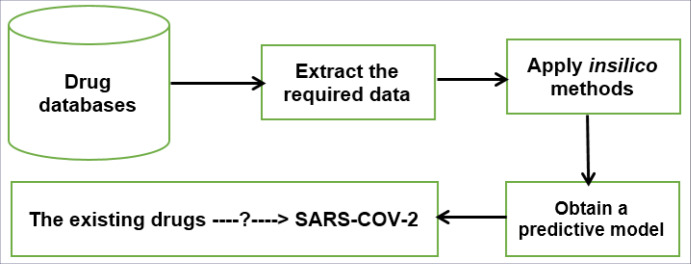Abstract
COVID-19, as a newly emerging disease, has disrupted human’s different activities. Hence, it is essential to develop drugs or vaccines in order to control COVID-19. Since there is not a medication or vaccine for treating the disease and drug development project is a time and cost consuming process, drug repurposing approaches may yield to proper curing plans. However, there are some limitations in this field, which make the process a challenging one. This letter aims to introduce drug repurposing methods and the existing challenges to detect candidate drugs which may be helpful in controlling COVID-19.
Keywords: COVID-19, Drug repositioning, In silico drug discovery
Dear the Editor,
COVID-19 is a viral disease with higher mortality than those caused by other common respiratory viruses, and its different aspects are not well understood. Given the typically long timelines for developing a drug or a vaccine, researchers have utilized drug repurposing techniques that try to detect hidden benefits of the existing drugs in managing COVID-19. Among the drug repurposing methods, computational approaches are more powerful than other techniques with regard to reducing time and cost and producing actionable results.1 There are several types of computational techniques that have been applied to drug repurposing in COVID-19.
The first approach is molecular docking, which investigates the affinity between the existing drugs and the structure of Severe acute respiratory syndrome coronavirus 2 (SARS-CoV-2), the virus that causes COVID-19.2 The main limitation of this class of approaches is that these methods cannot be applied for all the existing drugs due to higher computational operations. In addition, if the structure of a drug or a target is unknown, molecular docking techniques cannot be used. Usually, molecular docking methods are used for justifying predicted rug-target interactions.
The second group of computational approaches is network-based techniques,3 which form a network based on the genes or proteins of the disease or virus-host interactome. Then, the network is extended, and the graph traversing algorithms are applied to it. The main limitation of the second class of techniques is that many biological aspects associated with the disease are unknown, and the network-based approaches may not yield promising drug candidates. Biological components interact with other elements and form a complex system. Hence, this class of methods may lead to more applicable outcomes.
The third group of methods is machine learning approaches, which are applied to detect potential drugs which may interact with SARS-COV-2. Although machine learning methods lead to better prediction models, these techniques are more dependent on the data than two mentioned classes. It seems that a combination of machine learning methods and other techniques can yield a powerful treatment plan for managing COVID-19.
All the computational-based drug repurposing methods strongly depend on data. Unfortunately, the existing databases present researchers with some challenges.4,5 First, in some databases, the volume of data is low to generate a suitable model. Second, to gather more comprehensive datasets, there is not a determinant identifier to connect data. Third, there are vague descriptions related to data, so it is difficult to understand them. Fourth, the databases include data for a specific goal and do not consist of comprehensive data. Fifth, different introduced API commands have made it too difficult for learning and utilizing them. In this field, software engineering concepts and standards can play a critical role and can free users from the difficulties.
Overall, it seems that drug repurposing methods are the most suitable approach to detect therapy plans for COVID-19. Among the drug repurposing methods, in silico-based approaches may lead to more acceptable outcomes than others in terms of enhancing efficacy and reducing the time and cost of a drug discovery project. Every computational drug repurposing method has its advantages and limitations and strongly depends on data. The existing databases face some limitations, which can be controlled by software engineering techniques.
Funding sources
None to be declared.
Ethical statement
There is none to be declared.
Competing interests
There is none to be declared.
References
- 1.Masoudi-Sobhanzadeh Y, Omidi Y, Amanlou M, Masoudi-Nejad A. Trader as a new optimization algorithm predicts drug-target interactions efficiently. Sci Rep. 2019;9:9348. doi: 10.1038/s41598-019-45814-8. [DOI] [PMC free article] [PubMed] [Google Scholar]
- 2.Elfiky AA. Anti-HCV, nucleotide inhibitors, repurposing against COVID-19. Life Sci. 2020;248:117477. doi: 10.1016/j.lfs.2020.117477. [DOI] [PMC free article] [PubMed] [Google Scholar]
- 3.Zhou Y, Hou Y, Shen J, Huang Y, Martin W, Cheng F. Network-based drug repurposing for novel coronavirus 2019-nCoV/SARS-CoV-2. Cell Discov. 2020;6:14. doi: 10.1038/s41421-020-0153-3. [DOI] [PMC free article] [PubMed] [Google Scholar]
- 4.Masoudi-Sobhanzadeh Y, Omidi Y, Amanlou M, Masoudi-Nejad A. Drug databases and their contributions to drug repurposing. Genomics. 2020;112:1087–95. doi: 10.1016/j.ygeno.2019.06.021. [DOI] [PubMed] [Google Scholar]
- 5.Masoudi-Sobhanzadeh Y, Omidi Y, Amanlou M, Masoudi-Nejad A. DrugR+: A comprehensive relational database for drug repurposing, combination therapy, and replacement therapy. Comput Biol Med. 2019;109:254–62. doi: 10.1016/j.compbiomed.2019.05.006. [DOI] [PubMed] [Google Scholar]



